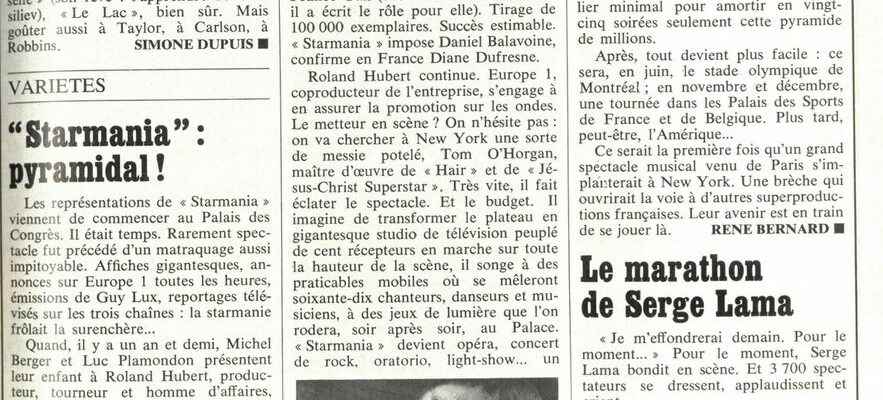For seven decades, our newspaper has covered and analyzed all the highlights of our contemporary history between decolonization, the Cold War, European construction, the advent of the Fifth Republic… It is committed to social struggles such as the abolition of the death penalty or the emancipation of women and welcomed great feathers like François Mauriac, Albert Camus or Jean-Paul Sartre. Turning the pages of our archiveswe invite you to relive the news of the past seventy years.
44 years after its release, Starmania continues to attract viewers. Since last November, more than 300,000 people have flocked to the Seine Musicale to applaud the new version of the famous hits written by Michel Berger and Luc Plamondon. The themes addressed such as terrorism and ecology, gender, still resonate in the news today.
In 1979, four days after the first performance of Starmania at the Palais des Congrès, L’Express detailed the underside of the creation of this first French blockbuster.
L’Express of April 14, 1979
starmania : pyramid!
The representations of starmania have just started at the Palais des Congrès. It was time. Rarely has a spectacle been preceded by such a pitiless beating. Gigantic posters, announcements on Europe 1 every hour, Guy Lux programs, television reports on the three channels: the starmania bordered on one-upmanship…
When, a year and a half ago, Michel Berger and Luc Plamondon introduced their child to Roland Hubert, producer, turner and businessman, he decided to try the adventure. starmania, it is precisely the evocation of a world whose rules of the game are reminiscent of those of show business: in Monopolis, a futuristic capital where you live in towers and underground, you have to become a star or disappear. The zonards cross the adventurers, and, among the political leaders, the ecological prophets, the mythomaniac record stores, a television presenter falls in love with a loubar on the run. “Romeo and Juliet in concrete”, explains Michel Berger. West Side Story in the basements ofClockwork Orange”.
“Starmania” in L’Express of April 14, 1979.
© / The Express
At the age of 30, Michel Berger, who signs the music, has already pinned to his list the first successes of Véronique Sanson, some of the best titles of Françoise Hardy and, by composing Music, brought France Gall back to life. Luc Plamondon, for his part, arrives from Quebec, via New York and London, loaded with a good number of songs written for Diane Dufresne and Pauline Julien. From the outset, Roland Hubert aims for the highest by choosing the Palais des Congrès, where he has already won bets that his competitors considered untenable: the marathons of Serge Lama, the “intimate” evenings of 4,000 spectators of Maxime Le Forestier. As the room is booked nearly two years in advance, Berger, for want of anything better, launches extracts from starmania on disc.
Plamondon brings his Quebec friends, Diane Dufresne, Fabienne Thibeault, Nanette Workman; Berger turns to France Gall (she is also his wife and he wrote the role for her). Edition of 100,000 copies.
Esteemable success. starmania imposes Daniel Balavoine, confirms in France Diane Dufresne. Roland Hubert continues. Europe 1, co-producer of the company, undertakes to promote it on the airwaves. The director ? We do not hesitate: we are going to look in New York for a kind of chubby messiah, Tom O’Horgan, project manager of Hate and of jesus christ superstar. Very quickly, he broke the show. And the budget. He imagines transforming the stage into a gigantic television studio populated by a hundred receivers in operation over the entire height of the stage, he thinks of mobile platforms where seventy singers, dancers and musicians will mingle, with plays of light that the ‘we will rode, evening after evening, at the Palace. starmania becomes opera, rock concert, oratorio, light-show… a monster, which requires, to be mastered, one hundred and forty technicians behind the scenes, including six Americans, “sound directors”, “movement directors”, “directors of dressing”, plus an interpreter to translate everything.
Objective: New York
A week before the premiere, the budget broke the 5 million threshold (for the record, Hate : 1,200,000 Francs; Mayflower : 1,500,000 Francs), 12% of the sum going to the musicians and performers, although the headliners have accepted a single fee of 1,000 Francs per day. O’Horgan, royal, asked him for 3% of the net revenue. Recipe which must reach, at all costs, 200,000 Francs per performance, the minimum level to amortize this pyramid of millions in just twenty-five evenings.
Afterwards, everything becomes easier: in June, it will be the Olympic stadium in Montreal; in November and December, a tour of the Palais des Sports in France and Belgium. Later, perhaps, America… It would be the first time that a great musical spectacle from Paris would be established in New York. A breach that would pave the way for other French blockbusters. shepherd
